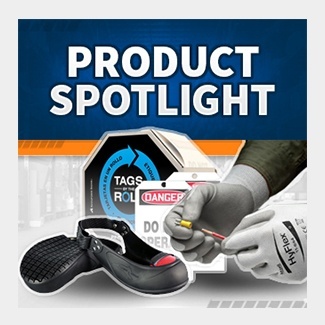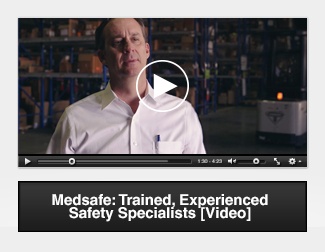You get to the worksite, put on your harness, and reach for your fall protection device. You've got two choices: a self retracting lifeline (SRL) and an energy absorbing lanyard. Which one do you use? Which is the right one for the job?
It's an important decision. Work-related falls result in more than 100,000 injuries and death each year. If you fall, using the wrong deceleration device could mean the difference between a close call and a disabling injury – or worse.
Falls from height are completely preventable, but only with the right equipment. If you fall, the deceleration device will bear most of the force. It is the critical link in our fall arrest system. That's why it's important to make sure you're using the right one every time. Need better clarification on the difference between fall prevention and fall protection? Read our informative blog "Fall Protection Vs. Fall Prevention."
In this post, we'll go over the pros and cons of energy absorbing lanyards and SRLs and give you advice about when you should use each. Knowing that will help you stay safe at any height.

Energy Absorbing Lanyards
Energy Absorbing Lanyards are one of the simplest fall arrest devices. Composed of webbing or cable, they are most commonly built at a length of no more than 6 feet. Energy Absorbing Lanyards have either internal or external shock-absorbing functionality. Both are suitable for fall arrest. Those without shock absorbers must only be used for restraint or positioning.
Energy Absorbing Lanyards are easy to use. During a fall, the energy absorber simply extends until it reaches it's limit. If a worker is wearing a 6-foot lanyard, they could (depending on how close they are to the anchorage point) free fall the entire 6-foot length (or more) before the energy absorber engages. It's not uncommon for the energy absorber to extend an additional 3-4 feet before it finally arrests the fall.
What Are the Benefits?
The main benefit of fall protection lanyards is cost. They are significantly cheaper than alternative devices. This makes them attractive to employers who need to keep their workers safe on a budget.
Energy Absorbing Lanyards can also be ideal for smaller workspaces. Equipment used in these areas is rigged to prevent the worker from reaching a potential fall hazard. Restraint applications like this take the entire working length of the device into account when determining which equipment is more appropriate. Longer length SRL's might not be the best choice in an application such as this, as they do not limit the user's ability to approach a potential fall hazard.
Do Energy Absorbing Lanyards Have Limitations?
One of the most significant drawbacks is the amount of fall clearance you need. On top of the 6-foot lanyard length, you have to add 3.5 feet for deceleration as well. Also included is the 2-foot OSHA safety margin and an average of 6 feet for worker height. That means your 6-foot lanyard could potentially need 18 feet of clearance below the anchor for safe use.
Using a lanyard can also restrict your movement. With fixed anchor points, you will only have a radius of 6 feet to conduct your work while attached. That might be enough for smaller workspaces. But if you need to move beyond that radius, you will need to connect to a new anchor point.
It's also important to consider that you might move around the worksite throughout the day. That means the available fall clearance is changing all the time, and you may not always have the 18 feet you need.

The Alternative: Self-Retracting Lifelines
Self-retracting lanyards , or SRL’s, come in a variety of types and styles. Some are compact and are worn in lieu of an Energy-Absorbing Lanyard and have a working length of perhaps six to ten feet. The more traditional types are larger and are typically mounted to a fixed, overhead anchorage and may feature a working length of anywhere from twenty to over one hundred feet. These devices essentially contain a spring wound drum containing a length of wire rope or webbing that will pay out and retract in response to the attached worker’s movements. In the event of a fall, these devices feature an automatic locking mechanism which creates the arresting engagement, as well as a brake or energy absorber which will decelerate the falling mass of the worker.
What Are the Benefits?
One of the main benefits of using an SRL is that you will generally require less clearance. A very small number are available which will have a total arrest distance of 24 inches or less (if mounted to an overhead anchorage), whereas most will arrest a fall in a distance of somewhere between 36 and 54 inches. Add the two foot OSHA safety factor and a typical worker of 6 feet in height, and the total clearance required below the anchor would be between 10 and 13 feet, provided that the anchorage was well overhead so as to not impart any free-fall due to slack in the line. This reduces the clearance requirements by about one-third.
Provided that the anchorage is overhead, the locking engagement is almost immediate, and the brake or energy absorber goes to work right away, limiting the forces as well as the total distance of the fall arrest. This greatly reduces the chances of striking the next lower level or an object in the fall path, thereby greatly reducing the opportunity for an injury to occur.
Falls happen, and that’s why having a safe fall arrest system in place is so essential. OSHA regulations mandate that employers have a rescue plan in place. If an employee falls, rescue must occur promptly. Since SRLs limit fall distances, employees using these devices can often self-rescue. Those who use energy absorbing lanyards generally can’t do this. This makes rescue procedures lengthier and more complex.
Do SRLs Have Limitations?
Even with all those advantages, an SRL may not be appropriate for every situation. An SRL must not be used with leading edges unless the device is specifically designed for this purpose.
It can also only be used safely where overhead anchorage is available. The devices are ineffective if anchored improperly. This includes anchoring below the dorsal D-ring or at foot level.
While it’s fairly simple to inspect energy absorbing lanyards, SRLs have more components, some hidden. This makes the inspection process more complicated. Using SRLs also might require more training, as they can be used in a variety of settings. Need to update your team on the newest in fixed ladder safety? Check out our blog "Ladder Safety: Recent Updates in Fall Protection."
Choosing Between the Two
Different work conditions call for different safety devices. Energy Absorbing Lanyards are most often appropriate for:
- Restraint applications, where the lanyard is meant to protect you from getting too close to a fall hazard
- When fall clearance remains the same throughout the entire workday (that is, when you aren’t moving around to different areas on the work site)
SRLs should most often be used:
- In situations where an energy absorbing lanyard wouldn’t be able to arrest the fall in time
- On fixed ladders
- In stairwells
In general, SRLs offer equal or better performance compared to lanyards. Energy Absorbing Lanyards will allow a worker to fall until all slack is gone. SRLs never allow for any slack in the line and can arrest falls more quickly.
Quick Comparison
|
Energy Absorbing Lanyard (6 feet) |
Self-Retracting Lanyard |
|
|
Budget |
Minimal expense |
More expensive than lanyard, but becoming more affordable |
|
Fall Clearance |
18 feet (typical) |
13 feet (typical) |
|
Mobility |
6 foot radius |
Limited only by length of lifeline |
|
Practicality |
Only used when fall clearance remains constant; not practical if worker is consistently moving to different areas on work site |
Can be used where fall clearance changes, as long as it remains greater than about 12.5 feet |
|
Rescue |
Requires employer rescue |
Employee can often self-rescue |
|
Uses |
Restraint applications; areas with consistent fall clearance of 18 feet or greater |
Fixed ladders; stairwells; situations that require near-immediate fall arrest |
The Most Crucial Consideration: Safety
Self-retracting lanyards can be used safely and efficiently in most situations. While they represent a larger expense upfront, the reliability and functionality of an SRL is well worth the cost. No matter which decelerator you select, remember to inspect each fall protection device before use. A thorough equipment check doesn’t just make for a safe workday, but could save your life.









